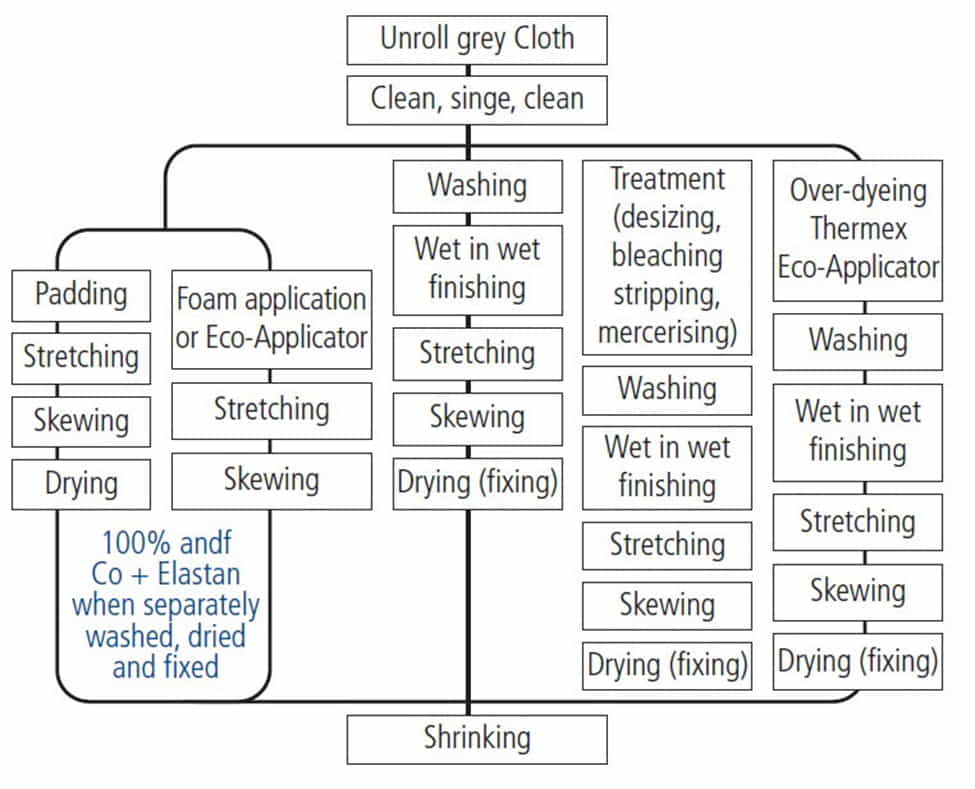Denim Fabrics Finishing
Denim is a quality product and is multipurpose it can be used as a garment and clothing as well as package or covering. It’s a diverse material with multiple types each with a unique quality. Denim has a lot of scopes and if used consciously can create a great scope for humanity. One of the best ways to shop in a sustainable way is to do so within the circular economy, prolonging the life of garments and keeping them out of landfills that much longer. Also since denim is a durable fabric hence, we can easily upcycle denim.
Fundamentals of Denim fabric Finishing
Finishing Process: Fabric finishing is the last stage in the production of denim. This is where the final touch is added, and it can make a big difference in how the fabric looks, feels and fades. Technically Fabric finishes are divided into two categories functional and aesthetic. They either work to correct and prevent issues of dimensional stability that control dimensions are crucial because unfinished denim shrinks as much as 10-12%.
The reason for that is summed up in one word: tension. During spinning, dyeing and weaving, denim stretches in length and width as the yarn is under continuous tension. Moreover, to enhance the look and feel of a fabric with what’s known as creative finishes. The processes can be mechanical, thermal or chemical.
Flow Chart of various Denim Finishing Process
The figure shows the treatment possibilities and processes. All the treatments always finish with the shrinkage process. Before the shrinkage process, a washing test should be performed prior to each fabric batch being shrunk in order to determine the shrinkage potential. The fabric shrinkage in warp and weft direction and the degree of skewing are measured.
The washing shrinkage in the warp direction and the degree of skewing provide indicative values for the setting of the denim shrinkage range. Essential denim completing, texture touches base from weaving straightforwardly, without de-estimating, and is brushed to expel tainting, seared with fire to make the texture smoother by lessening shagginess, cushioned with a basic formula, disregarded a couple of skew moves to diminish texture torque which causes skew development and after that dried. Basic finishes given to greige denim fabric are mechanical and chemical or a combination of both.

Objects of Fabric Finishing:
- To increase the attractiveness of fabric.
- To increase the serviceability.
- To increase the beauty and brightness of fabric.
- To increase the fineness and to ensure smoothness.
- To ensure the softness of the fabric.
There are two types of finishing process used.
- Mechanical finishing
- Chemical finishing
Mechanical finishing is of two types
- Flat finishing
- Regular finishing
The difference between Flat finishing and Regular finishing is 4 wash boxes are used in flat finishing but no wash box in the regular finishing process.
Mechanical finish
Singeing process– twice on the blue side; Stretching — longitudinally to set the desired fabric width; Weft straightening — pulling the weft threads to prevent twisting; Compressive shrinkage. Gas singing machines

What is Singeing?
Natural Indigo Blue Dye Origin Dying Procedures Technology and Dye Recipes for Denim Fabrics
Natural INDIGO Dye – THE KING OF NATURAL DYES
Denim Fabric Weaving – Manufacturing Process, Methods, and technologies
Manufacturing process of Denim Fabrics
Singing is the process of burning out the projecting fibre from the yarn or fabric surface to increase the smoothness and evenness of the fabric. A good singeing ensures a better fabric for that reason printing quality on fabric will be more than the normal condition. Based on the requirements several singeing methods are used in the textile industry. Here in this article, we will discuss single meaning, objectives, and classification.
Objective of Singeing
- Burning of projecting fibres from the yarn/fabric surface.
- Fabric/Yarn surface becomes smooth, even, and clean.
- Maximum Luster in the fabric is produced by the mercerizing process.
- Help to create a smart design by printing.
- Save from uneven dyeing and printing.

Plate Singeing
In plate singeing open fabric is passed upon the copper plate. To maintain ever speed some guide roller and draw roller are used. The temperature of singeing plates is heating but the problem is the plate temperature vary. The processing speed varies at 135-225 m/min.


Advantages of Plate Singeing
Due to friction between cloth surface and copper plate fabric surface become smooth.
Disadvantages of Plate Singeing
Copperplate not to be evenly so uneven singeing is performed.
Roller Singeing
- Some defects of plate singeing machine are overcome in roller singeing machine.
- In the roller singeing machine, there is used a rotating cylinder instead of a stationary curved plate as a plate singeing machine. It may be made of either copper or cast iron and provided with an internal firing system.

The gas–singeing machine is commonly used and is typically equipped with four burners, and is capable of singeing one or both surfaces of the fabrics. A water-cooled roller is provided at a location opposite to the burners, thereby enabling singeing to be performed without undermining the strength of even thin fabrics.





